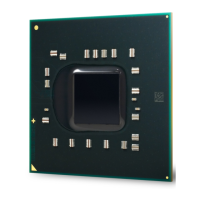Intel Thermal/Mechanical Reference Design Information
Thermal and Mechanical Design Guidelines 41
This design does not use a fan hub thermistor. Additional acoustic improvements can
be achieved at lower processor workload by using the T
CONTROL
specifications described
in section
2.2.3. Intel recommendation is to use the Fan Specification for 4 Wire PWM
Controlled Fans to implement fan speed control capability based on the digital thermal
sensor. Refer to Chapter
6 for further details.
5.1.3 Altitude
The reference heatsink solutions were evaluated at sea level. However, many
companies design products that must function reliably at high altitude, typically
1,500 m [5,000 ft] or more. Air-cooled temperature calculations and measurements
at sea level must be adjusted to take into account altitude effects like variation in air
density and overall heat capacity. This often leads to some degradation in thermal
solution performance compared to what is obtained at sea level, with lower fan
performance and higher surface temperatures. The system designer needs to account
for altitude effects in the overall system thermal design to make sure that the T
C
requirement for the processor is met at the targeted altitude.
5.1.4 Reference Heatsink Thermal Validation
The Intel reference heatsink was validated within the specific boundary conditions
based on the methodology described Section
5.2, and using a thermal test vehicle
(refer to section Error! Reference source not found.).
Thermal testing is done in a thermal chamber (due to the slight change in fluid
properties at elevated temperatures) on test fixtures to secure the heat exchangers at
the appropriate ambient temperatures. Acoustic testing is completed in an ATX
chassis representing a micro-tower configuration.
The test results, for a number of samples, are reported in terms of a worst-case
mean + 3σ value for thermal characterization parameter using real processors (based
on the thermal test vehicle correction factors).

